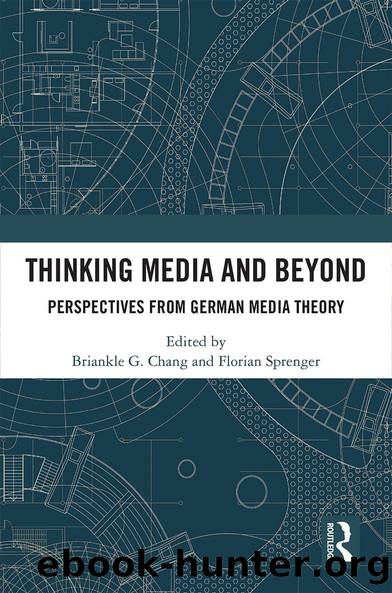Thinking Media and Beyond by Briankle G. Chang Florian Sprenger

Author:Briankle G. Chang, Florian Sprenger [Briankle G. Chang, Florian Sprenger]
Language: eng
Format: epub
ISBN: 9780367891862
Barnesnoble:
Publisher: Taylor & Francis
Published: 2019-12-17T00:00:00+00:00
3. Communicating sticks
Descartesâ world system appears to be closed unto itself due to this desire for contact between bodies and the fear of voids. But the system has one lock keeping it shut â action at a distance. Instantaneity is the key to this lock. Instantaneity implies that something can have an effect at two places at once without any delay in time: immediately, without any medium in between. Using a slender stick as an analogy, one that appears in different variations in his work, Descartes breaks down the universe.
He frequently refers to the blind manâs stick and the sense of sight to make his points. On one hand, sight as a primary sense is closely connected to the act of cognition. On the other hand, sight occurs as a transmission across distance without actually transporting anything, and therefore must be immediate. Additionally, and central to the argument of this text, Descartes makes use of the stick to explain action at a distance as well: By substituting lightâs physical action at a distance with a continuous chain of actions in proximity between corpuscles, actions which necessarily occur at the same time through the entire chain, Descartes introduces the notion of instantaneity. Its mediation ultimately reveals itself as that which is unthought-of in this philosophy. Every symbolic order has its âdisorderâ that must be excluded, a disorder that nevertheless renders the system of order effective insofar as the order requires the exclusion to be ordered at all; yet this exclusion continues to haunt the symbolic order.11 Mediation, communication, and immediacy can be described in this historical formation only in conjunction with one another.
Descartesâ order of the universe is pervaded by vortexes, by particle streams, and by different forms of invisible matter. These aspects of the Cartesian system would later be decried by the Newtonians on account of this systemâs attention to detail and aspiration to explain every event in the universe as âPhilosophical Romances ⦠contrivâd for the Diversion of the lazy and talkativeâ (Hales 1727, p. 265). Because Newton assumes other forces than just pressure and impact, the French Cartesians consider him to be anti-mechanistic since the gravitational force Newton argues for is regarded as occult by the Cartesians. Unlike Newton, Descartes seeks to prove without contradiction that the universe consists of interconnected corpuscles, which move in circular motions and can explain all appearances of nature as effects of pressure and impact. Descartes thus takes a different path than that of Newton with the latterâs active force of gravitation.
The notion of a gapless plenitude of the universe entails an extremely powerful differentiation that divides res cogitans, thinking or mental things, from res extensa, extended things, that is, matter entirely describable through analytic geometry. If all matter is extended and anything extended is material, if extension and matter are then identical, there can be no empty space. An empty space would be nothing and nothing cannot exist since only res cogitans and res extensa exist. The res extensa encompass three different types of matter with different degrees of fit and continuities amongst them.
Download
This site does not store any files on its server. We only index and link to content provided by other sites. Please contact the content providers to delete copyright contents if any and email us, we'll remove relevant links or contents immediately.
| Coloring Books for Grown-Ups | Humor |
| Movies | Performing Arts |
| Pop Culture | Puzzles & Games |
| Radio | Sheet Music & Scores |
| Television | Trivia & Fun Facts |
Spare by Prince Harry The Duke of Sussex(4195)
Paper Towns by Green John(4169)
Never by Ken Follett(2879)
Learning C# by Developing Games with Unity 2021 by Harrison Ferrone(2869)
Fantastic Beasts and Where to Find Them: Illustrated edition by J.K. Rowling & Newt Scamander(2467)
The Man Who Died Twice by Richard Osman(2297)
Machine Learning at Scale with H2O by Gregory Keys | David Whiting(2289)
0041152001443424520 .pdf by Unknown(2220)
How The Mind Works by Steven Pinker(2213)
Fairy Tale by Stephen King(2068)
Will by Will Smith(2041)
Fantastic Beasts and Where to Find Them: The Original Screenplay by J. K. Rowling(2040)
Reminders of Him: A Novel by Colleen Hoover(1878)
The God delusion by Richard Dawkins(1848)
Borders by unknow(1785)
Rationality by Steven Pinker(1764)
The Dawn of Everything: A New History of Humanity by David Graeber & David Wengrow(1570)
The Artist's Way by Julia Cameron(1561)
Cloud Cuckoo Land by Anthony Doerr(1434)
